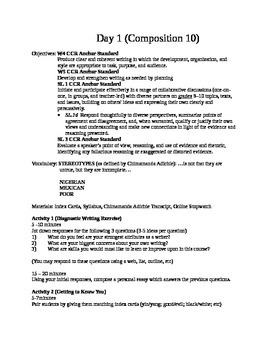Composition 10 Course Lesson Plans (Week 1)
Schmidtty Imani
45 Followers
Grade Levels
9th - 12th
Subjects
Resource Type
Standards
CCSSW.9-10.4
CCSSW.9-10.5
CCSSSL.9-10.1d
CCSSSL.9-10.3
Formats Included
- Word Document File
Pages
17 pages
Schmidtty Imani
45 Followers
Description
This collection of lesson plans is a great foundation for beginning a composition course.
The first lesson allows for students to explore their own biases through discussion and video viewing.
The link to TED talk, "The Danger of A Single Story" by Chimamanda Adichie is included.
Guiding Questions, as well as a transcript of the talk are also included.
The transcript may be intimidating for students, but you can chunk it if you choose. It is simply a way for students to provide evidence to support any claims they make in their written or verbal responses.
*The transcript may have typos/errors; you may want to proof-read before distributing to students OR have them search for and correct the errors as a grammar/spelling activity.
The lessons that follow build upon elements of writing. I do apologize that handouts and powerpoints may be references that are not available, but my hope is that they can still be helpful. Each lesson is based upon a 90 minute class.
The first lesson allows for students to explore their own biases through discussion and video viewing.
The link to TED talk, "The Danger of A Single Story" by Chimamanda Adichie is included.
Guiding Questions, as well as a transcript of the talk are also included.
The transcript may be intimidating for students, but you can chunk it if you choose. It is simply a way for students to provide evidence to support any claims they make in their written or verbal responses.
*The transcript may have typos/errors; you may want to proof-read before distributing to students OR have them search for and correct the errors as a grammar/spelling activity.
The lessons that follow build upon elements of writing. I do apologize that handouts and powerpoints may be references that are not available, but my hope is that they can still be helpful. Each lesson is based upon a 90 minute class.
Total Pages
17 pages
Answer Key
N/A
Teaching Duration
4 days
Report this resource to TPT
Reported resources will be reviewed by our team. Report this resource to let us know if this resource violates TPT’s content guidelines.
Standards
to see state-specific standards (only available in the US).
CCSSW.9-10.4
Produce clear and coherent writing in which the development, organization, and style are appropriate to task, purpose, and audience.
CCSSW.9-10.5
Develop and strengthen writing as needed by planning, revising, editing, rewriting, or trying a new approach, focusing on addressing what is most significant for a specific purpose and audience.
CCSSSL.9-10.1d
Respond thoughtfully to diverse perspectives, summarize points of agreement and disagreement, and, when warranted, qualify or justify their own views and understanding and make new connections in light of the evidence and reasoning presented.
CCSSSL.9-10.3
Evaluate a speaker’s point of view, reasoning, and use of evidence and rhetoric, identifying any fallacious reasoning or exaggerated or distorted evidence.




